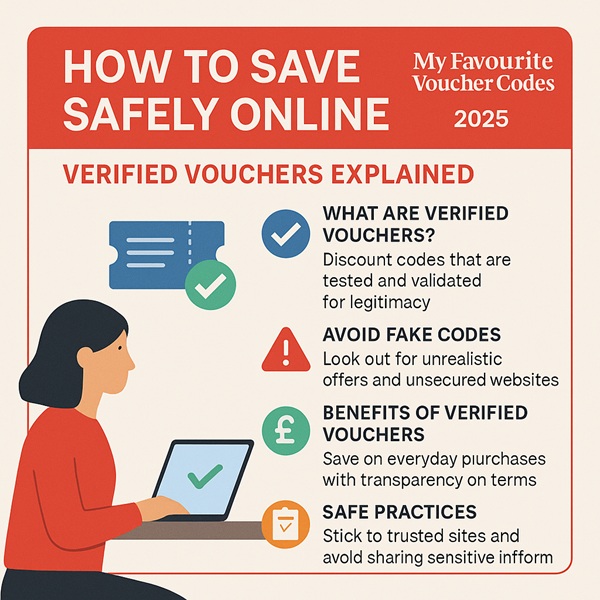How to Save Safely Online: Verified Vouchers Explained
With inflation, rising bills, and tighter household budgets, more and more people in the UK are turning to online voucher codes as a way to make ends meet. Verified discount codes can offer real savings on groceries, utilities, fashion, travel, and more. But while the opportunity is clear, there’s an increasing number of risks — fake voucher sites, phishing schemes, and misleading offers are popping up. It’s more important than ever to know how to tell the difference between a genuine deal and a scam. This guide is designed to help you succeed in two ways: first, by showing you the potential of vouchers for saving; second, by equipping you with the tools and knowledge to use them safely. We cover what vouchers are, how verification works, warning signs of scams, and steps you can take to protect yourself. By the end, you'll feel confident using verified vouchers to stretch your pounds — without falling prey to fraudsters. Recent data shows that UK households’ saving behaviour has shifted under pressure: the household saving ratio rose to 11.1% in Q1 2024, having dropped during 2022. ONS – Households’ finances and saving, UK: 2020 to 2024. Meanwhile, scams are a constant concern. Citizens Advice warns consumers to watch out for offers that look “too good to be true” and to verify that voucher sites are legitimate. Citizens Advice – Check if something might be a scam. Over recent years, online vouchers have moved from “nice to have” to “essential” for many UK households. As inflation rates soared and everyday costs—from energy bills to food—rose, more consumers turned to voucher codes and discount tools as a way to stretch tight budgets. Affordable savings can make a real difference, especially for families, students, and anyone watching their spending. According to recent research, more than 90% of British consumers have used a discount code or voucher at some point. Food shopping leads the way, with around 65% of UK adults using vouchers when buying groceries. Digital formats are accelerating fast: loyalty cards, discount alert apps, and smartphone‐friendly voucher platforms are becoming mainstream. UK Coupon Statistics 2025: Consumer Trends & Market Insights reports that email remains a key delivery route for vouchers, with more than three-quarters of grocery shoppers using digital grocery coupons in 2024. Mobile phone usage is also heavily influencing voucher behaviour. A study by Airship and Sapio Research found that 80% of consumers in the UK now regularly access stored loyalty cards and coupons via their smartphones while shopping—even in physical stores. It reflects a shift to “always on” savings. :contentReference[oaicite:1]{index=1} Furthermore, insights from MyVoucherCodes suggest that on average, each online purchase with a voucher generates a saving of about £14.62, and if all online shoppers used a working code, consumers collectively could save as much as £815 million annually. These figures show not just opportunity—they show what’s possible when voucher usage becomes routine. Not all vouchers are created equal. Alongside legitimate savings opportunities, there are growing numbers of fake voucher sites, phishing attempts, and misleading discount offers that can cost you more than you save. Recognising the risks is the first step toward safeguarding your money and personal data. Cybersecurity concerns are shifting how UK shoppers behave. According to data from Opinium, around 66% of consumers are now reconsidering how and where they shop online following prevalent cyberattacks. Nearly a quarter say they will only purchase from brands they fully trust. Retail Times – Two thirds of UK consumers change habits due to cyberattacks Moreover, the 2024 UK Consumer Detriment Survey found that a significant portion of consumer harm comes from online purchases. Issues such as misleading pricing, poor product quality, and incomplete refunds are reported by many — especially in the clothing and footwear sectors, electronics, software, and marketplaces. Consumer Detriment Survey 2024 Voucher codes can be a safe, simple way to reduce everyday costs — but only when they’re genuine, in-date, and clearly explained. Verification protects shoppers from misleading discounts, expired offers, and outright scams, while ensuring the small print is visible before you buy. We verify offers before publishing, include the key terms in plain English, and remove or flag anything that’s expired or unclear. We also highlight any spend thresholds or product exclusions at the top of the offer. This approach supports UK guidance on fair promotions and price transparency while keeping your online shopping safe. CMA price transparency (draft); ASA promotional rules. Vouchers don’t just feel helpful — the data shows they make a measurable difference for households under financial pressure. After dipping to around 6.6% in mid-2022, the UK household saving ratio has steadily recovered, reaching approximately 11.1% by Quarter 1 of 2024. This rise corresponds with rising cost-of-living, increasing interest rates, and more cautious spending behaviour. ONS – Households’ finances and saving, UK: 2020 to 2024 ([ons.gov.uk] UK households have accumulated an estimated £143 billion to £338 billion in excess savings since the start of the COVID-19 pandemic. These savings are driven by reduced consumption during lockdowns, government support measures, and more cautious spending. Households have generally been reluctant to spend these accumulated savings, instead opting to hold them as precautionary buffers. ONS data ([ons.gov.uk] Meanwhile, analysis by IBISWorld indicates that the UK’s household saving ratio is expected to hover around 10.3% for 2024-2025, roughly 3.9 percentage points higher than pre-pandemic levels. IBISWorld – UK Household Savings Ratio Report Voucher codes can deliver genuine savings, but it’s vital to stay alert and use them wisely. This checklist gives you practical steps to shop confidently and avoid scams. By following these steps, you can be confident that the savings you make are genuine and that your personal data remains secure. Bookmark a small set of trusted resources so you can save with confidence and avoid the noise. The links below are well-known UK platforms and consumer-protection pages that help you find genuine offers and shop safely. Tip: If a “voucher site” asks for your card details before showing a code, or promises impossible savings, leave immediately and use one of the trusted resources above. Meet Sarah, a working parent from Manchester balancing the rising costs of food, school supplies, and household essentials. Like many UK consumers, Sarah turned to the internet to find ways to stretch her budget. Her first experience wasn’t positive: she clicked on a website that promised “80% off” across major supermarkets. After completing a survey and handing over her email address, she received no valid code and was later bombarded with spam offers. It was a stressful and disappointing introduction to vouchers online. Determined to save safely, Sarah switched her approach. She began using verified voucher platforms that clearly displayed expiry dates, source information, and retailer links secured by HTTPS. On her weekly grocery shop, she found a working £5 off code for Sainsbury’s, plus a free delivery voucher for a clothing order. Within a month, Sarah had saved over £120 on essentials and cut down the time wasted chasing fake deals. Sarah’s experience highlights two important points: By choosing trusted voucher providers, Sarah turned frustration into confidence. Her story reflects what many UK households can achieve: secure, sustainable savings that really make a difference. Voucher codes can be a powerful way to reduce the pressure of everyday costs. From groceries and household essentials to clothing and travel, verified discounts give UK consumers the chance to keep more money in their pockets. But as the risks of scams and misleading offers continue to grow, the importance of using trusted voucher providers has never been greater. This guide has shown you how the world of online vouchers works, the dangers of fake codes, and the clear benefits of verification. The data proves it: households that shop smartly can save hundreds each year — without compromising safety or falling for scams. When you choose verified voucher sites, you gain: Ready to shop smarter? Explore verified vouchers at My Favourite Voucher Codes and start saving safely today — with the added bonus that 20% of our profits go to charity each month.
The Rise of Online Vouchers in the UK
The Dark Side: Fake & Scam Voucher Codes
Warning Signs of Fake Voucher Sites
Examples & Recent Cases
Risks to Consumers
Why Verification Matters
What “verification” actually means
How verification protects consumers
Our approach to verified vouchers
Data & Statistics: Real Impact of Vouchers in the UK
UK Saving Ratio Trends
How Much Households Have Saved Since the Pandemic
Comparisons & Regional Spend
Why This Matters for Voucher Use
Safe Practices Checklist
Verified Resources for Consumers
Trusted UK Voucher & Deals Platforms
Official Student Discount Platforms (Verification Required)
Consumer-Protection Guidance (Shop Safely Online)
Case Study: Saving Safely with Verified Vouchers
Conclusion: Save More, Shop Safely





